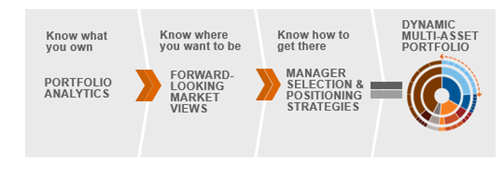Adjusting your portfolio? 3 implementation capabilities to keep in mind
Let's assume you've done the work to know where you want to be. You've decided on the asset class shifts and the revised underlying asset-class structures. Maybe you've even researched specific investment manager products and selected the actual managers. If you do all this well, you have a best-laid plan, right? What could go awry?
For part three of this blog post series, we'll talk about the fact that many a genius investment strategy has failed because of poor implementation. In order to get where you want to go requires not just a great implementation strategy, but also requires real-world implementation capabilities.

At Russell Investments, we believe best-practice asset managers need capabilities in manager research, trading, transition management, overlays, currency, and precise direct investment (also known as positioning strategies). At a higher level, we think in terms of three main implementation levers, ranging from broad to precise:
- Swapping out money managers
- Adjusting manager weights
- Precise direct investment strategies
Movable money managers
Let's say that a money manager assigned to a portfolio needs to be replaced. Perhaps they are not executing their investment process as expected, or there has been turnover on the investment team that concerns you, or you simply have to make room for a higher conviction manager.
Once you've completed the hard work to identify the replacement, real world considerations of how to actually transition assets come into focus. This can be a complex process depending on the country domiciles, regulatory environment, currency considerations, and liquidity associated with the incoming and outgoing managers. For an asset manager without the right capabilities, this process can be fraught with opportunities for inefficiency, unwanted tax events, and loss of market exposure. To do this well requires transition management expertise. A skilled transition management team can make this process highly efficient and minimise opportunity cost. How do you know if your transition management team has your best interests in mind? At a minimum, be sure the provider you choose fully discloses their fees and provides complete transparency, particularly while the event is in process.
Manager weight adjustments
Replacing a manager is a significant action. Instead of swapping out a manager completely, we more typically look at moving exposures from one manager to another depending on the risks and tactical opportunities we observe across our entire opportunity set. For example, as I mentioned in my last blog post, we saw that value stocks had outperformed growth stocks substantially in 2016. So, after value had its run, we wanted to trim high and take some profits. We knew where we wanted to be. So we shifted exposure from value managers to growth managers.
But whenever exposure changes are made, there are still inefficiencies to be avoided. Trading expertise is vital. For maximum trade efficiencies, we believe trading expertise should be held to a high bar, with the following best-practice characteristics:
- 24-hour staffing – When global markets are open, the trading desk should be open. How can tactical opportunities be maximised and risks be minimised if the desk is closed?
- A pure agency model – The structure of an agency model removes potential conflicts of interests. The structure itself demands that the trading desk works on behalf of the client, not on behalf of the asset manager. By its nature, it eliminates conflicts associated with proprietary books.
- Specialisation – Markets are complex and understanding the nuances of individual asset classes is vital. We believe traders should be organised to specialise by asset class, including fixed income, equities, derivatives, and foreign exchange transactions.
Precision through direct investments strategies
When it comes to the fine-tuning of a portfolio, we also recommend using internal direct investment strategies separate from money managers, as this allows for greater precision, speed, and flexibility in achieving your dynamic preferred positioning. Direct investment strategies may include derivative-based overlays or custom-built quantitative strategies.
As an example of how this can work in a global equity portfolio, consider a situation where more exposure to Japanese equity is desired relative to the existing country exposure in a portfolio. However, we often find that active managers are chronically underweight Japanese equities. In this case, a portfolio manager may use a direct investments strategy, such as a futures overlay, to bring the entire portfolio's exposure to Japan in line with their preferred positioning. Additionally, depending on the hedging strategy desired in the portfolio, a direction investments strategy can also include currency forward contracts to disentangle the Japan equity exposure from the Yen currency exposure. Taken all together, direct investment strategies are custom-designed to ensure that a portfolio's position is fine-tuned to improve both the risk and return profile of a portfolio, often with a focus on reducing downside risk. But to do this well, we believe expertise in trading both physical securities and derivatives in real time is a requirement.
Completing the circle
As we've shown here, we clearly believe that a best-practice asset manager will have a robust capability set, including open-architecture money managers and skills in transition management, trading, and derivatives.
Here's the catch: Investing this comprehensively requires a clear view of a total portfolio at any given moment. This is why it is so important—so necessary—to know what you own, which takes us back to my first blog post. And thus the cycle starts again.
Note: This is the third blog in a three-part series: Know what you own; Know where you want to go; Know how to get there.